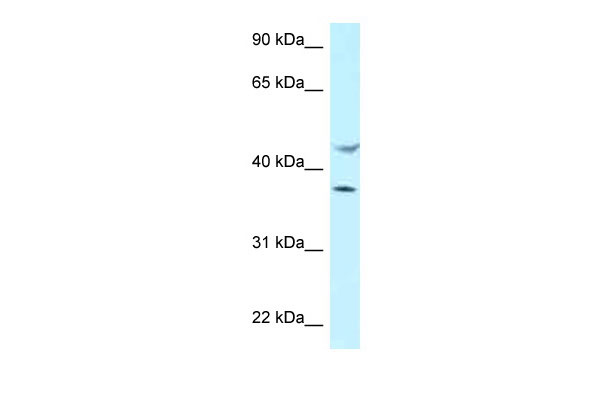HLA-E antibody - C-terminal region
Rabbit Polyclonal Antibody
- 产品详情
- 实验流程
Application
| WB |
|---|---|
| Primary Accession | P13747 |
| Other Accession | NM_005516, NP_005507 |
| Reactivity | Human, Mouse, Pig |
| Predicted | Human |
| Host | Rabbit |
| Clonality | Polyclonal |
| Calculated MW | 40058 Da |
| Gene ID | 3133 |
|---|---|
| Alias Symbol | DKFZp686P19218, EA1.2, EA2.1, HLA-6.2, MHC, QA1 |
| Other Names | HLA class I histocompatibility antigen, alpha chain E, MHC class I antigen E, HLA-E, HLA-6.2, HLAE |
| Format | Liquid. Purified antibody supplied in 1x PBS buffer with 0.09% (w/v) sodium azide and 2% sucrose. |
| Reconstitution & Storage | Add 50 ul of distilled water. Final anti-HLA-E antibody concentration is 1 mg/ml in PBS buffer with 2% sucrose. For longer periods of storage, store at 20°C. Avoid repeat freeze-thaw cycles. |
| Precautions | HLA-E antibody - C-terminal region is for research use only and not for use in diagnostic or therapeutic procedures. |
| Name | HLA-E {ECO:0000303|PubMed:9486650, ECO:0000312|HGNC:HGNC:4962} |
|---|---|
| Function | Non-classical major histocompatibility class Ib molecule involved in immune self-nonself discrimination. In complex with B2M/beta-2-microglobulin binds nonamer self-peptides derived from the signal sequence of classical MHC class Ia molecules (VL9 peptides - VMAPRT[V/L][L/V/I/F]L) (PubMed:18083576, PubMed:18339401, PubMed:35705051, PubMed:37264229, PubMed:9754572). Peptide-bound HLA-E- B2M heterotrimeric complex primarily functions as a ligand for natural killer (NK) cell inhibitory receptor KLRD1-KLRC1, enabling NK cells to monitor the expression of other MHC class I molecules in healthy cells and to tolerate self (PubMed:17179229, PubMed:18083576, PubMed:37264229, PubMed:9486650, PubMed:9754572). Upon cellular stress, preferentially binds signal sequence-derived peptides from stress- induced chaperones and is no longer recognized by NK cell inhibitory receptor KLRD1-KLRC1, resulting in impaired protection from NK cells (PubMed:12461076). Binds signal sequence-derived peptides from non- classical MHC class Ib HLA-G molecules and acts as a ligand for NK cell activating receptor KLRD1-KLRC2, likely playing a role in the generation and effector functions of adaptive NK cells and in maternal- fetal tolerance during pregnancy (PubMed:30134159, PubMed:37264229, PubMed:9754572). Besides self-peptides, can also bind and present pathogen-derived peptides conformationally similar to VL9 peptides to alpha-beta T cell receptor (TCR) on unconventional CD8-positive cytotoxic T cells, ultimately triggering antimicrobial immune response (PubMed:16474394, PubMed:20195504, PubMed:30087334, PubMed:34228645). Presents HIV gag peptides (immunodominant KAFSPEVIPMF and subdominant KALGPAATL epitopes) predominantly to CD8-positive T cell clones expressing a TRAV17-containing TCR, triggering HLA-E-restricted T cell responses (PubMed:34228645). Presents mycobacterial peptides to HLA-E- restricted CD8-positive T cells eliciting both cytotoxic and immunoregulatory functions (PubMed:20195504, PubMed:35705051). |
| Cellular Location | Cell membrane; Single-pass type I membrane protein. Golgi apparatus membrane |
| Tissue Location | Expressed in secretory endometrial cells during pregnancy (at protein level). The expression in nonlymphoid tissues is restricted to endothelial cells from all types of vessels, including arteries, veins, capillaries, and lymphatics (at protein level). In lymphoid organs, it is mainly expressed in endothelial venules, B and T cells, monocytes, macrophages, NK cells and megakaryocytes (at protein level). |
Research Areas
For Research Use Only. Not For Use In Diagnostic Procedures.
Application Protocols
Provided below are standard protocols that you may find useful for product applications.
REFERENCES
Mizuno S.,et al.J. Immunol. 140:4024-4030(1988).
Ulbrecht M.,et al.Eur. J. Immunol. 29:537-547(1999).
Ishitani A.,et al.Submitted (JUN-2002) to the EMBL/GenBank/DDBJ databases.
Shiina S.,et al.Submitted (SEP-1999) to the EMBL/GenBank/DDBJ databases.
Koller B.H.,et al.J. Immunol. 141:897-904(1988).
终于等到您。ABCEPTA(百远生物)抗体产品。
点击下方“我要评价 ”按钮提交您的反馈信息,您的反馈和评价是我们最宝贵的财富之一,
我们将在1-3个工作日内处理您的反馈信息。
如有疑问,联系:0512-88856768 tech-china@abcepta.com.























 癌症的基本特征包括细胞增殖、血管生成、迁移、凋亡逃避机制和细胞永生等。找到癌症发生过程中这些通路的关键标记物和对应的抗体用于检测至关重要。
癌症的基本特征包括细胞增殖、血管生成、迁移、凋亡逃避机制和细胞永生等。找到癌症发生过程中这些通路的关键标记物和对应的抗体用于检测至关重要。 为您推荐一个泛素化位点预测神器——泛素化分析工具,可以为您的蛋白的泛素化位点作出预测和评分。
为您推荐一个泛素化位点预测神器——泛素化分析工具,可以为您的蛋白的泛素化位点作出预测和评分。 细胞自噬受体图形绘图工具为你的蛋白的细胞受体结合位点作出预测和评分,识别结合到自噬通路中的蛋白是非常重要的,便于让我们理解自噬在正常生理、病理过程中的作用,如发育、细胞分化、神经退化性疾病、压力条件下、感染和癌症。
细胞自噬受体图形绘图工具为你的蛋白的细胞受体结合位点作出预测和评分,识别结合到自噬通路中的蛋白是非常重要的,便于让我们理解自噬在正常生理、病理过程中的作用,如发育、细胞分化、神经退化性疾病、压力条件下、感染和癌症。






